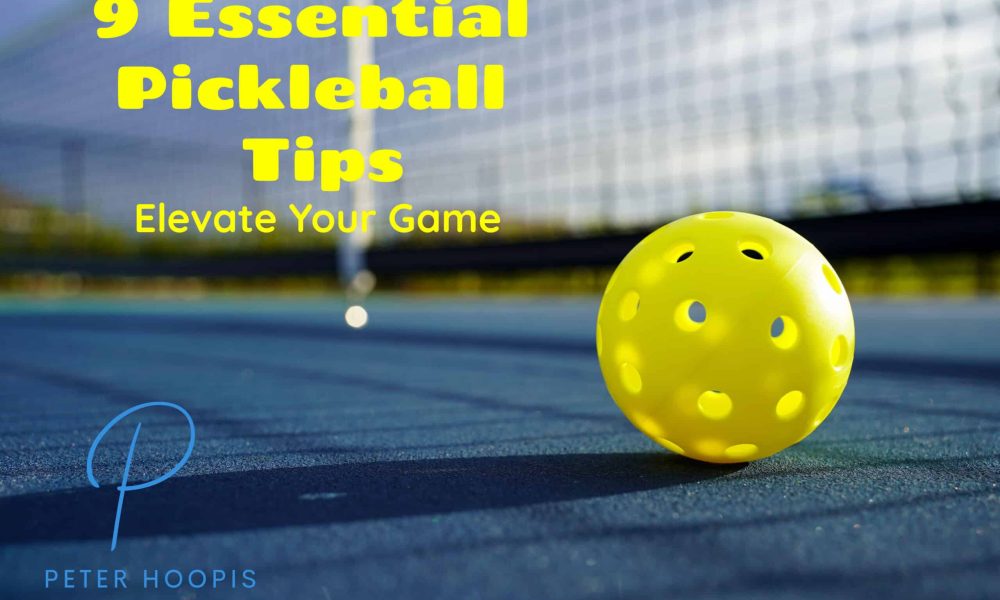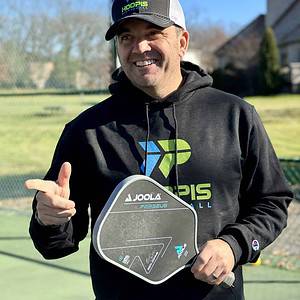Are you new to the sport of pickleball and looking for some pickleball tips to improve your game?
Or maybe you’ve been playing for a while, but feel like you’re stuck in a rut?
No matter where you’re at in your pickleball journey, there are always ways to up your game and have more fun on the court.
Just like any sport, practice makes perfect. This is especially true in the world of pickleball, where mastering the basic techniques and developing good habits is essential to achieving success on the court.
In this blog post, we’ll be sharing 9 essential pickleball tips that will take your game to the next level. Incorporating these tips into your practice and pickleball game will improve your skills, help you become a better player, get more points, and ensure that you get the most out of every match.
So, let’s get started!
What Are The 9 Essential Pickleball Tips?
Tip #1: Get The Upper Hand With A Consistent Serve

The serve is an important piece of the game that can often go overlooked. Sometimes it might just seem like a formality to start the point, but doing it correctly can give you and your team a big advantage. Here are some tips on how to execute a good, consistent serve:
- Keep a nice relaxed and loose grip when you serve. Let the pickleball paddle lag behind your hand as your strike the ball.
- The serve must be done underhand and contact with the ball must be made below your belly button. The paddle head needs to be lower than your wrist when it makes contact with the ball. It is important to make contact with the ball out in front for better and more consistent serves.
- You can either bounce the ball or hit it directly from a drop when you serve. I prefer and suggest doing it off the drop as that aids in more consistency. You don’t have to worry about how hard to bounce it, or if the ball happens to bounce awkwardly or even if there is wind it can mess up your bounce serve.
- The serve must be executed from behind the baseline. After contact is made you can move anywhere on the pickleball court.
- Have a pre-serve routine. I do the same thing before I serve. You will see many players do this. It creates predictability and routine for you to have a consistent, flawless serve.
- Remember to finish your swing when you serve. We see a lot of errors when people don’t finish their follow-through on their swing. You should finish your swing over your opposite shoulder.
- Avoid snapping your wrist or flicking your wrist on the serve. It’s important to use your shoulder in your serve.
- Serve deep into your opponents court and try to serve to their weak shot, which for many is the backhand.
- And even though I talk about having a consistent serve, it is still important to mix up the placement of your serve or even your serve speed. You don’t need to do this too often but every now and then you can try an out wide serve, a higher pace or even a lob serve just to keep your opponents guessing.
Tip #2: Take Control With The Return Of Serve
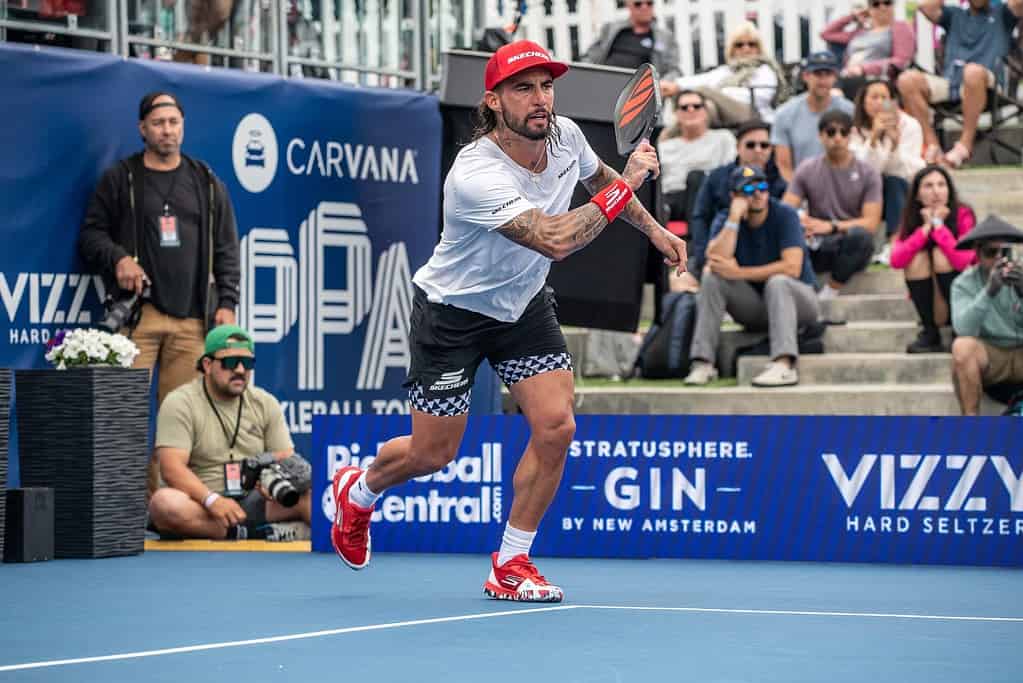
Your first chance to take over control of the point! Let’s take advantage of it. Our ultimate goal is to keep the serving team back and away from the non-volley zone line(or the kitchen line). Here are a few things we can do to take control, score points and have a great return of serve:
- Be in the ready position. Don’t get caught off guard here. Ideally, you want to be 2-3 feet behind the baseline, feet shoulder width apart and your knees bent slightly, on the balls of your feet.
- Be light on your feet. You can bounce a little or move your feet. This will keep you ready to react and try to position yourself for a forehand return which is most players’ more favorable shot.
- The serve comes fairly quickly, so take a nice short backswing to get your paddle into position. Keep your return swing under control and compact.
- Your goal of the return is to have a nice deep shot down the middle of the court. Try not to aim for the baseline as that may cause unforced errors if you go too deep. Instead, aim a couple of feet short of the baseline to improve your margin of error. Returning down the middle will cause the opposing team to have to choose who returns it and this may cause some confusion or it may force them to use a backhand that they may not want to use.
- After you return the serve, move to the kitchen line fast! If you are having trouble making it to the kitchen line and getting caught in the transition zone you can try putting a little more air under your return shot to give yourself more transition time to get to the no volley line.
Tip #3: Dominate With The Third Shot Drive
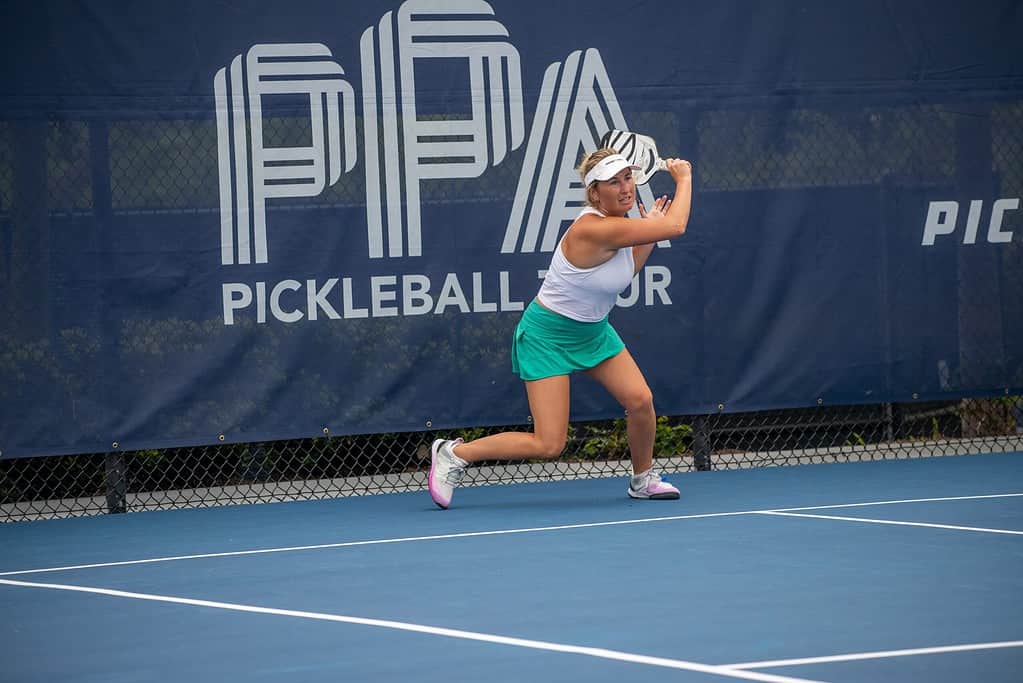
With your third shot, you typically have two options; the drive or the drop. For the drive, it is a fast, hard shot where you are trying to neutralize certain shots from your opponents and get to the NVZ so you can take over the point. Here are some tips for a good third-shot drive:
- It is usually a good time for a drive when the opponent sends you a shot with a short return and a high bounce. This allows you to step into it and give it a good hard shot as you move forward to the kitchen line. Shot selection is key.
- Even though this is a hard, fast shot, this isn’t your “kill” shot or hard-core winner. The goal of the drive is a setup. It’s not 100% as hard as you can swing, but it is still a firm swing.
- It is important to stay compact and finish your swing when you drive.
- Turn your body in particular your hips and shoulders. Step into your shot.
- Move fast after your drive to get to the kitchen.
- Target backhands, down the line, the middle of the court, or the person who returned the serve.
Recommended Article: The Best Pickleball Bags
Tip #4: Master The Difficult Third Shot Drop
Third shot drops, as opposed to the drive, are soft shots usually from the baseline with the goal of landing the ball in your opponent’s kitchen. Its essentially a long drop shot. The goal is to make your opponent hit up on the ball. This is a difficult shot to execute but for those who can, it can turn into a great advantage for their pickleball game.
- It is usually a good time for a third shot drop when you receive a low return or it keeps you back.
- A cross-court drop shot is common to take advantage of the low point of the net.
- You want the ball to peak on your side of the court so it is descending as it goes over the net.
- Hit the ball to land low in your opponent’s kitchen. You want them to have to hit up on the ball on their next shot to keep them from attacking.
- Remember to practice this often as this is a very difficult shot to master!
Tip #5: Dominate the Dink
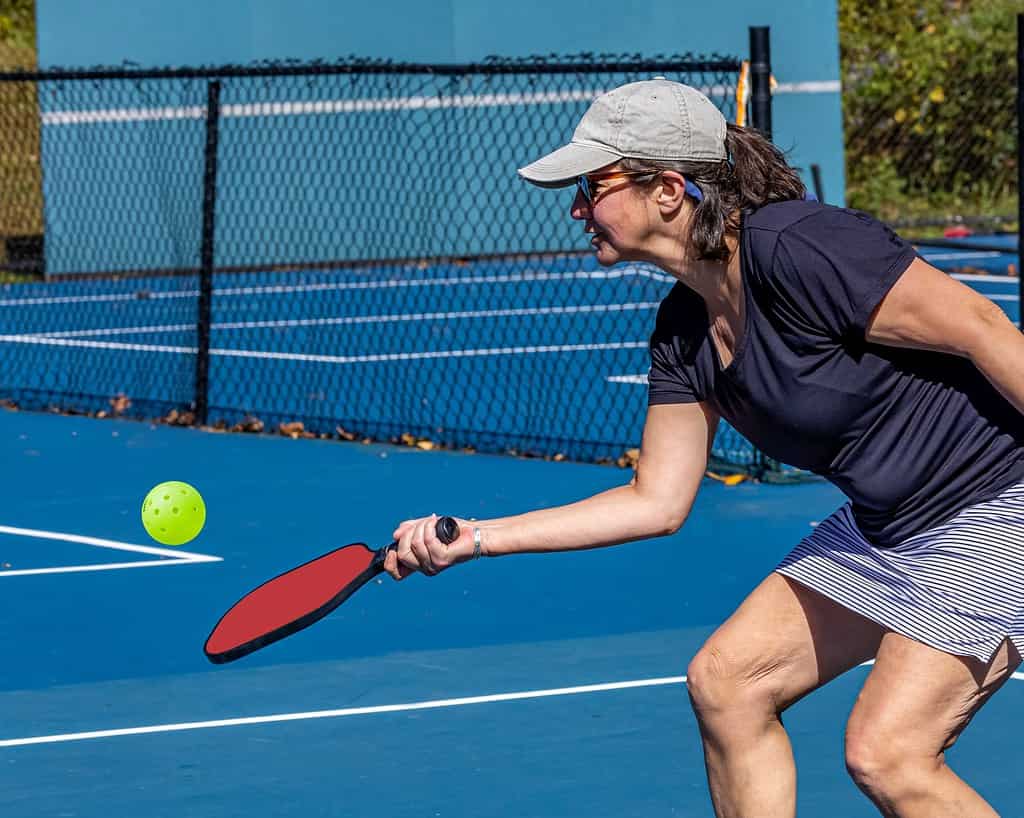
The Dink. The pride and joy of pickleball. The dink is pickleball. Don’t you just love the pickleball terms?!?
So, how do you master it? We need to remember what the goal of the dink shot is and that is to keep the ball low and make it unattackable for the opposing team. Dinks are all done at the non volley zone line. Here are some tips for a great dink:
- Keep a short backswing and make contact with the ball with your paddle out in front. Gently lift from your shoulder. Don’t flick your wrist.
- Watch the ball all the way to hit your pickleball paddle
- Slide your feet or shuffle when you move side to side. Don’t cross your feet over and tie your feet up. This will help you move efficiently and cover more ground. This will also keep you in a good ready position to hit your next shot.
- The dink can be offensive or defensive in your pickleball game.
- Hold the line! It’s important to maintain control of no volley line on your side of the pickleball court.
Tip #6: Volley, Volley, Volley
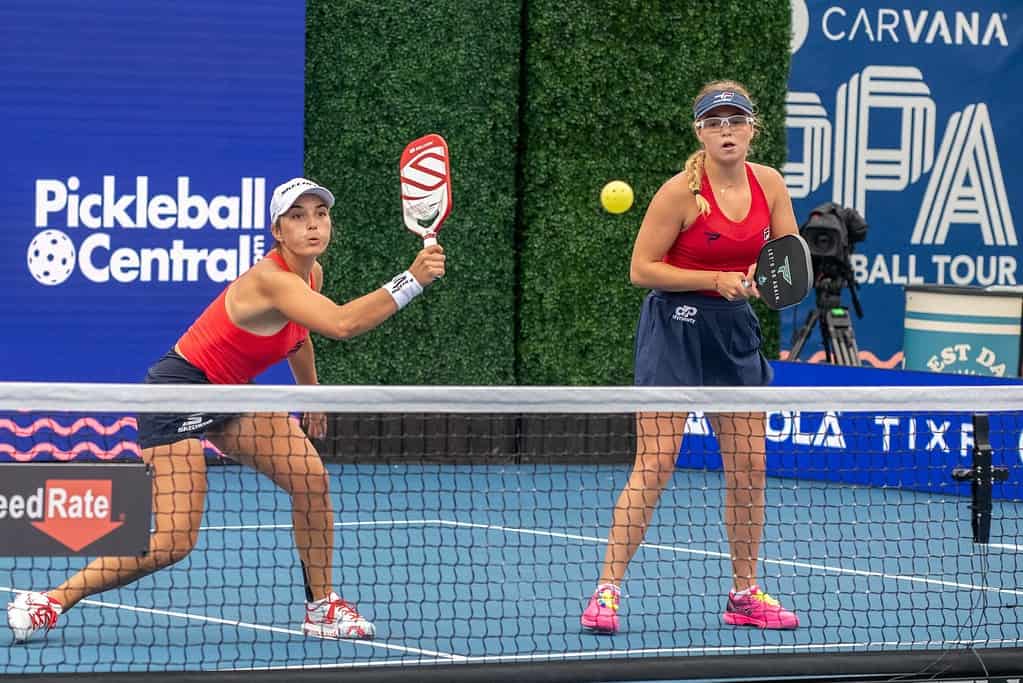
The volley is very common in pickleball which is why it is important to have a good one. A volley is when you hit the ball out of the air before it bounces. You are usually positioned at the non-volley zone line. There are two basic types of volleys. You either have a more defensive type volley which would be the block volley. This is more of a reaction to a shot coming right at you where you just kind of block the ball and it goes back. The more offensive volley is the swing volley or punch volley. This is when you are trying to take the offensive aggressive position.
Here are a few tips to work on a good volley:
- Keep your paddle out front in the ready position. The shots come fast so you need to be prepared and have good reaction time.
- Keep your knees bent slightly and have a fairly loose grip on the paddle to help absorb some of the impact.
- You want to make contact with the ball out in front of your body. The volley is all about touch and feel.
- Your target areas will be down the middle, at your opponent’s feet, at your opponent’s weak side most likely their backhand, or right at your opponent’s body.
- Try to avoid hitting your volley too hard and taking it deep out of bounds. The unforced errors always come back to haunt you!
Tip #7: Don’t Be Afraid To Lob Offensively
You see a lot of lobs end with an overhead smash for the winning shot. It is usually the result of the player defending great drives or smashes, eventually ending with the winning shot. However, the lob can be used as an offensive shot as well.
With the offensive lob, you and your opponents are all at the non-volley zone. Your goal is to lob it just over the heads of your opponents and have the ball land in bounds behind them hoping they can’t get to it to return. Even if they can, it usually results in a defensive lob for them which will keep you on the offensive. Here are a few tips for the lob:
- Always try to disguise it. Wait til the last second to start your lob if you can. You don’t want to give them any sort of heads-up that they need to start running back.
- Don’t let the ball get too low before you hit your lob since you won’t be able to get under it enough to be able to hit it high.
- Use the sun to your advantage. Lob more when your opponents have to look into the sun to return it. However, try to stay unpredictable to keep your opponents off guard.
Tip #8: Make Your Overhead A Winner
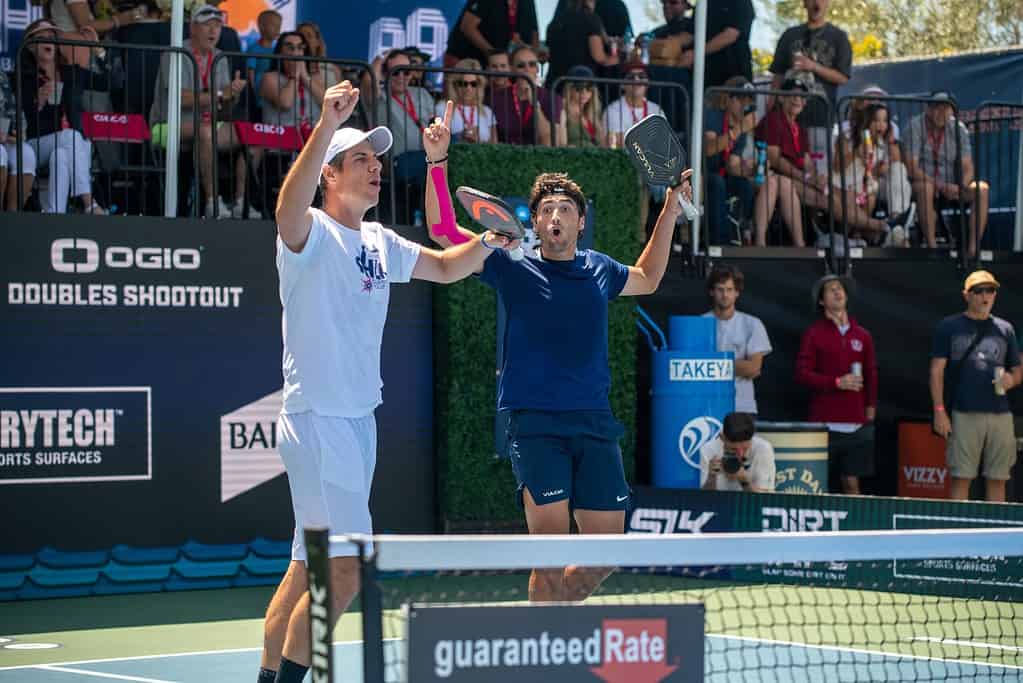
Ah the overhead smash. Nothing feels better than an overhead winner…and nothing feels worse than an overhead going into the net or out of bounds! Ugh! You essentially have two options when someone lobs it back at you. You can take it out of the air and be offensive, or let the ball bounce and return more defensively. If you have the opportunity and set up is right, I highly suggest taking it out of the air and going for win.
Here are some tips to make your overhead a winner:
- When the lob is coming back at you and you need to get into position, rotate your body and move back sideways. Avoid backpedaling as this can cause you to trip up. It is much easier to move back in a sideways run than running backwards.
- When going for it, keep your elbow up and your paddle by your ear.
- Point at the ball with your non paddle hand. This helps with aim and gets your body in the right position.
- As you swing for your overhead, have full extension of your arm and follow thru down and slightly across your body
- Celebrate your winner with a fist pump ?
Tip #9: Don’t Get Caught In No Man’s Land
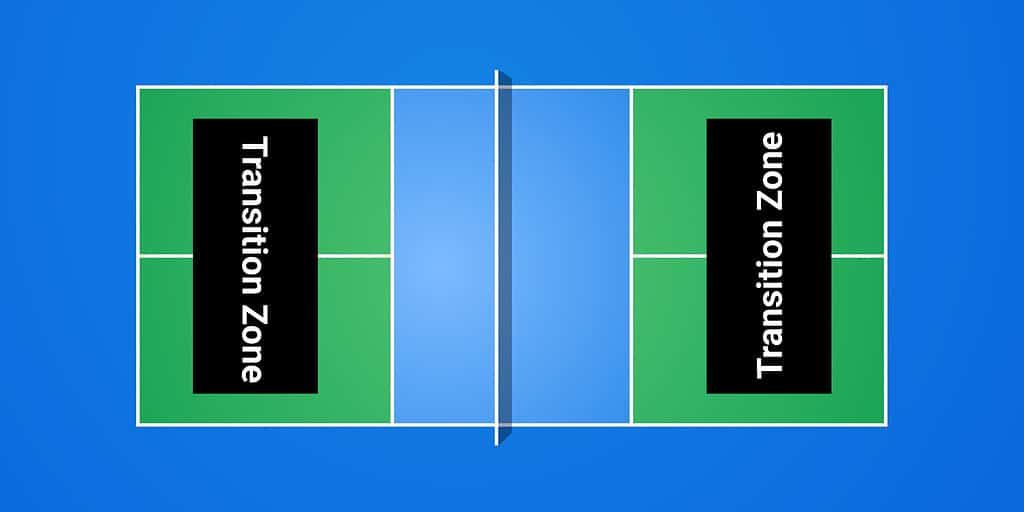
No man’s land or the transition zone is an area mid court that we all want to avoid. This is the area in between the baseline and the non-volley zone line. Nothing good happens here. Your opponents immediately have the upper hand with your bad court positioning. They can hit right at you or your feet making it difficult to return the shot. Here are some tips to avoid getting caught in the transition zone:
- We all know we need to move to the non volley zone line quickly, but we also need to move quickly under control! Sometimes you can get yourself out of position, or your feet crossed up when moving up to the NVZ line. This leaves you susceptible to attack from your opponent.
- Move with anticipation. As you move to the NVZ line, know that the ball is coming back at you or your partner. Try to anticipate where they might hit their next shot.
- As you transition and the ball comes at you, keep your paddle out front, get low with a wide stance to return it back while you are moving forward. This will keep you better balanced and give you a better return.
- Stay linked with your partner. That means, moving in unison. You should always be parallel with you partner. You do not want one player at the NVZ line and the other at the baseline. This leaves you open and it’s hard for you to cover all that ground.
How Can I Practice?
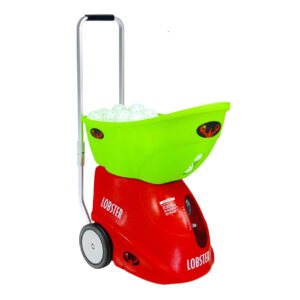
There are many different ways to practice and improve your game. Here are a few of my favorite methods:
- Solo Drills: One of the simplest ways to practice and work on your pickleball skills is to hit the ball against a wall. This can help you work on your shot placement, footwork, and timing. Plus, you don’t need a partner to do it! Or, you can get a pickleball ball machine and set up on a court! Even better!
- Partner Drills: If you have a partner, there are a variety of pickleball drills that you can do together to improve your game. Some popular ones include dinking drills, third-shot drop drills, and volley drills.
- Play Games: Of course, one of the best ways to get better at pickleball is to play as many games as possible. Whether it’s in a league, at a local park, or with friends, the more you are playing pickleball, the more comfortable you’ll get with the sport.
- Watch Videos: There are many great resources out there for learning about pickleball strategy and pickleball technique. Watching videos on YouTube or other platforms can be a great way to pick up tips and tricks from more experienced players.
- Attend Pickleball Camps: If you’re serious about improving your game, you may want to consider attending a pickleball camp or workshop. These can be a great way to get personalized instruction and to connect with other players who are also looking to improve.
No matter how you choose to practice, the key is to stay motivated and focused on your goals. With consistent effort and dedication, you can play pickleball like a pro!
Conclusion
Pickleball is a great sport that requires skill, strategy, and dedication to be successful. With the right practice techniques such as solo drills, partner drills, playing games, watching videos and attending clinics, you can become an expert in no time! The key is to stay motivated and focused on your goals so that you can take your pickleball game to the next level. So what are you waiting for? Grab a paddle and hit some balls today!

